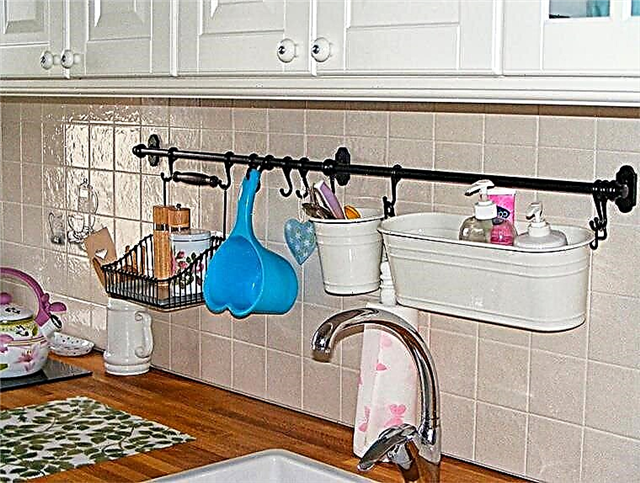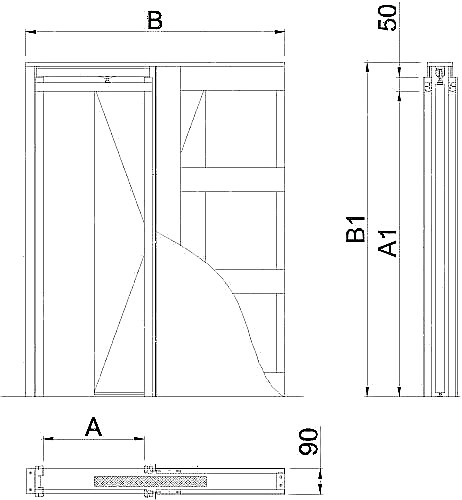
No one will argue that one of the best options to transform and decorate a summer cottage is to install an artificial pond on it. A small pond can be not only a decorative element in the aesthetic design of a land allotment, but also be of practical use.
For example, it can be used for fish farming, swimming or as a fire tank. Each owner himself determines the purpose of his cottage mini-reservoir. Depending on the goals that the owner pursues, the dimensions of the pond and the options for its arrangement and location are determined.
Location selection
If the owner of the site has an irresistible desire to engage in fish farming, a reservoir with sizes from 30 to 50 square meters and a depth of about 2 meters is suitable for this. It should be located in an open area where the sun's rays will warm it up in the morning, and in the afternoon and until the evening it will be slightly obscured by shadow. Observance of this condition will not allow it to overheat, as a result of which the rate of reproduction of algae, which takes oxygen from the inhabitants of the fauna, is reduced. Better to choose a place among the flower beds. So it will look more harmonious and picturesque.
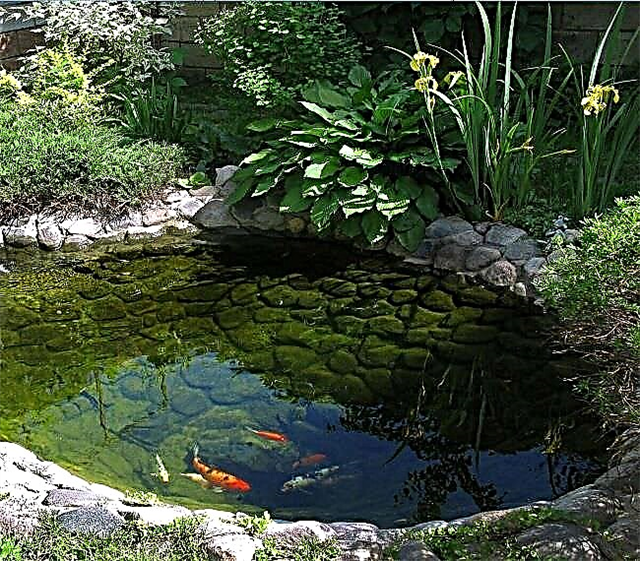
If when choosing a place there are no suitable options due to the fact that there is not enough vegetation on the site, then you will have to create a shadow artificially. Small trees or shrubs that can be planted around it will do. Plants with too powerful root systems will not work. They may eventually destroy the shores of the pond. And in the case of using a film, this option is not at all suitable.

The issue of organizing a reservoir at a summer cottage specifically for swimming should be approached no less responsibly. Indeed, if the place is chosen incorrectly, the cottage pool will be heavily and quickly contaminated, which will lead to quick spoilage of water.

To avoid this, the following conditions must be met:
- The bathing tank should be located in a place remote from garden trees in order to maximally exclude falling leaves falling into the water.
- The pond must be planned in an elongated shape, and positioned in the direction of the blowing winds. This will greatly facilitate the work of cleaning the reservoir, as all trash falling into the water will accumulate in one part of it.
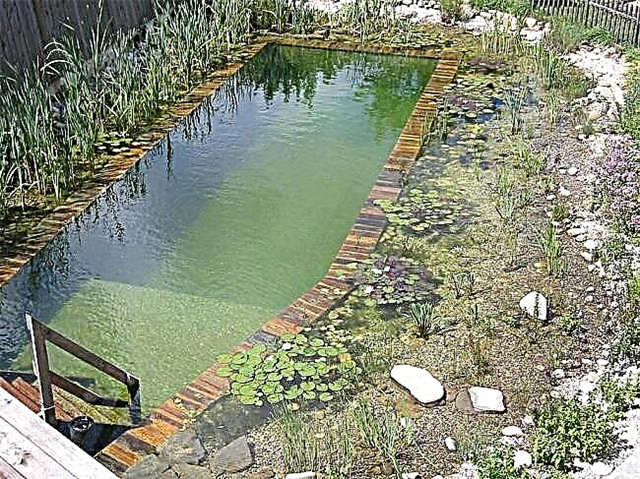
- The organization of the bath should be carried out in a place heated by sunlight for no more than two hours a day. This time is quite enough to warm the water, and prevent its flowering as a result of overheating.
- If the pond is planned to be used only as a firefighter, or for household needs, for example for irrigation of a garden, the requirements at its location may be less serious.
Important! Do not use water from an artificial reservoir for drinking or cooking, without first checking its quality in the laboratory, and without making sure of its safety!
Before choosing a place for a pond as just a decorative element, you need to choose a place for convenient water supply. All these questions need to be thought out in advance. The farther he is from home, the more difficult it will be to solve technical issues. If a decorative fountain is installed in a pond, then it will be necessary to take care of the electrical cable.

Manufacturing options
There are only three types of water body facilities on the site:
- On a rigid basis, by concreting the pit.
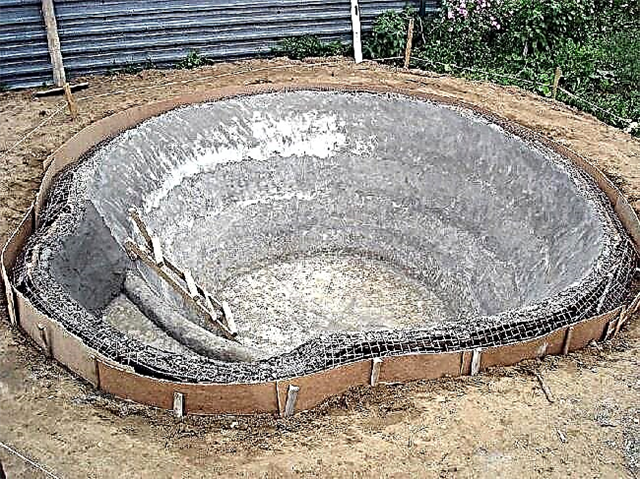
- By mounting a polymer container in the pit.

- Using a special film.
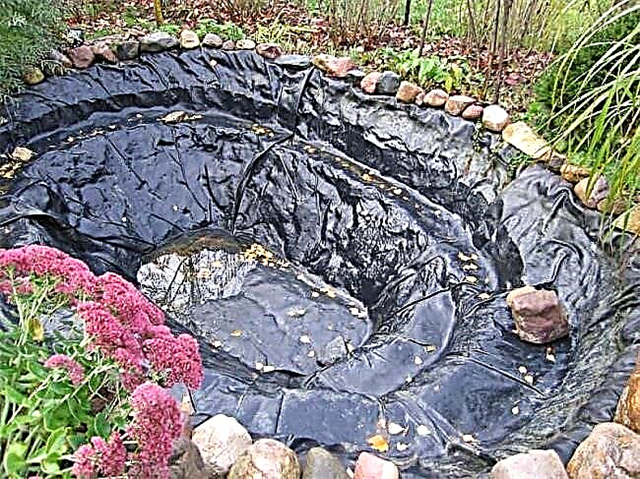
The method in which the bottom of the pit is covered with a simple plastic film is not a reliable option. Except for application butyl rubber, the cost of which is much higher than polyethylene. But when choosing such a film, you need to pay attention to its quality. It should have a sufficient thickness and density, designed specifically for creating a pond, not less than 1.5 mm. This film has a lot of advantages. These include: frost resistance, the ability to create any shape, strength and resistance to ultraviolet radiation.
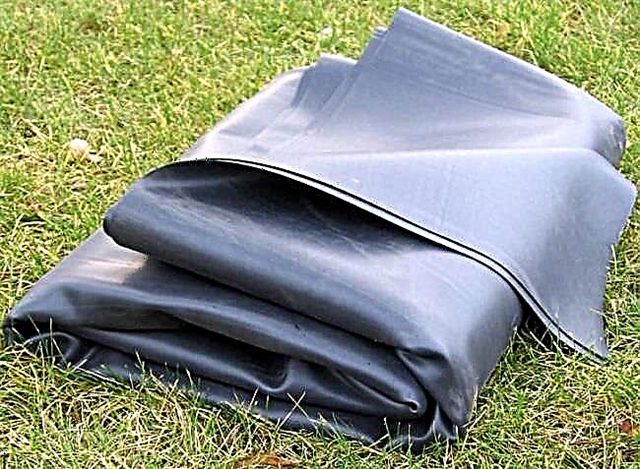
Plastic reservoirs for pond construction are affordable, affordable for most, easy to install and quite durable in their characteristics, but do not differ in a variety of shapes and sizes. They are great for creating mini ponds. This option is suitable for creating a summer pond. In winter, you can not drain the water. Manufacturers do not recommend leaving the tank empty to avoid deformation. But in this case, it is necessary to leave it at ground level.

Concreting a foundation pit is a more expensive and time-consuming method of organizing an artificial pond, but it has one significant advantage: it is more durable and will require a rarer and less significant repair.

Such a pond also has the ability to create any size and shape of the bowl. The disadvantages of this option can be considered instability to low temperatures and the need for special treatment if living organisms are bred in it. Such a reservoir for the winter is better to drain. To avoid exposure to frost. All inhabitants will have to be cleaned accordingly.
The sequence of work with the device of the reservoir
When choosing any option for organizing a water tank on a land plot, it is necessary to clearly and consistently follow the general stages of work in order to avoid further introduction of unnecessary corrections and alterations. This process will have several stages in stages.
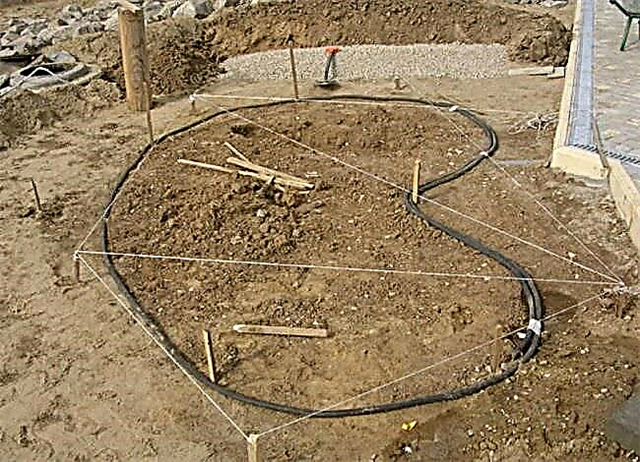 Create a contour with a hose
Create a contour with a hose

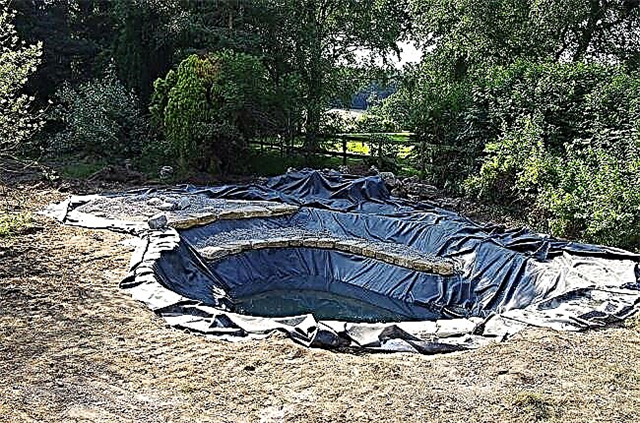

All stages are performed differently depending on which version of the artificial reservoir is selected. It is worthwhile to understand the creation of a reservoir of each type.
The device of a concrete reservoir
Before proceeding with the installation of such an option, it is necessary to understand that if there is no experience with concrete structures, it is better to entrust this work to professional builders. In violation of the technology of mixing concrete and pouring it, such a bowl will not last long. It will not be possible to avoid cracks, which will lead to leakage of water and its pollution from the soil layers.
The stages of building a concrete pond are as follows:
- Marking the future pit under a pond. To do this, you can use a hose or rope.

- Preparation of the pit. At this stage, earthwork should be carried out using the necessary equipment or manual labor. In this case, it all depends on the financial capabilities of a single owner. At this stage, it is necessary to thoroughly clean both the walls and the bottom of the pit of large stones and plant roots.
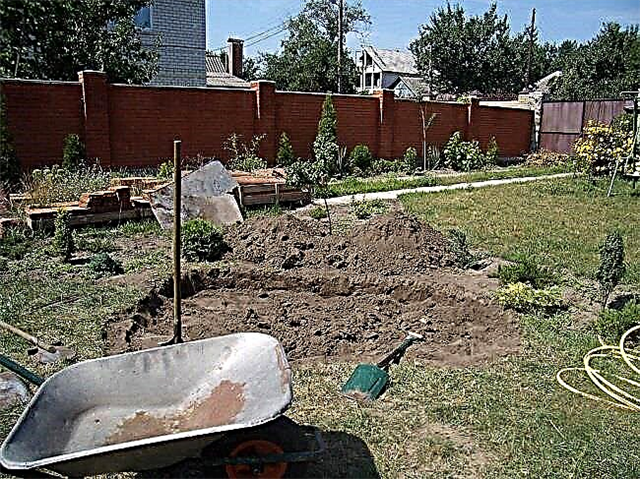
- At the bottom and sides of the pit, lay a plastic film and a reinforcing mesh. You can use a welded mesh.
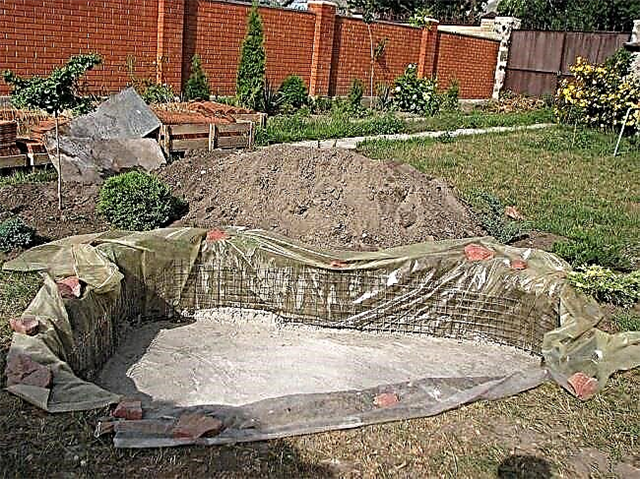 It fits along the entire perimeter. At this stage, even before pouring concrete, a drain pipe should be installed. It is also necessary to consider the location of the power cable if a filter pump is installed.
It fits along the entire perimeter. At this stage, even before pouring concrete, a drain pipe should be installed. It is also necessary to consider the location of the power cable if a filter pump is installed. 
- Concrete is poured over the reinforcing mesh. At the edges of the reservoir, you need to install the formwork, and gradually form the banks of the reservoir.
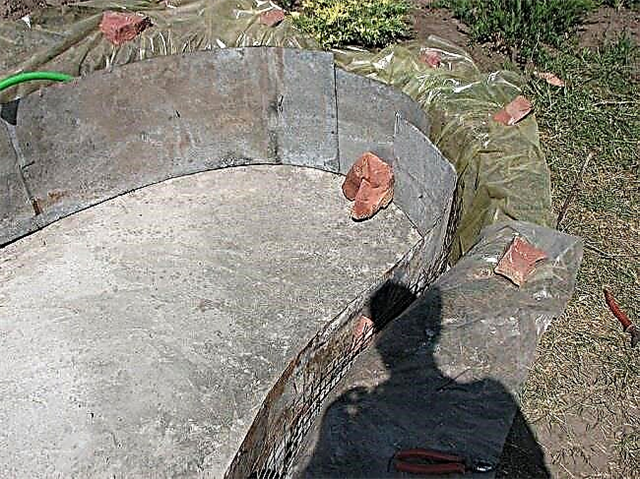 They can be gentle or have a certain shape. At this stage, it is necessary to use concrete solutions of the highest grades suitable for the construction of reliable monolithic structures.
They can be gentle or have a certain shape. At this stage, it is necessary to use concrete solutions of the highest grades suitable for the construction of reliable monolithic structures. 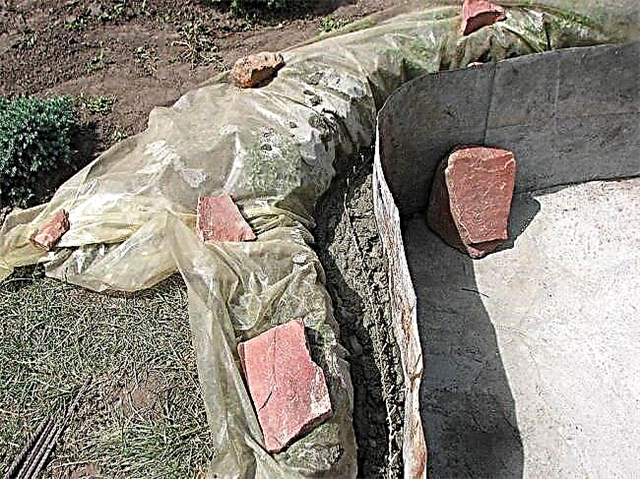
- After the concrete has solidified completely, it is necessary to proceed with waterproofing the bowl. Various materials may be used for this. It can be a special paint, membrane or mastic.
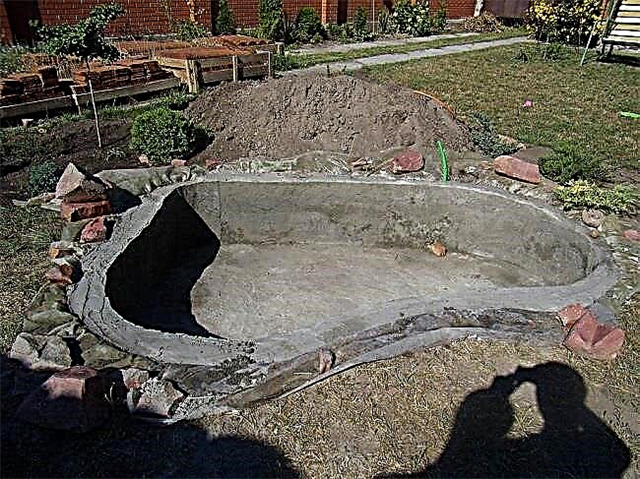
- At the last stage, you can think about the decorative design of the pond. In a concrete pond, you can install a waterfall made of stones. And the banks are lined with small pebbles.
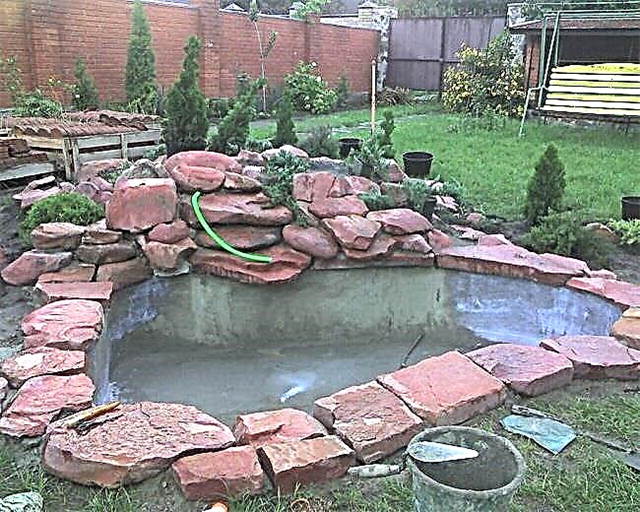
When building this type of pond, you should not save on concrete. Thin walls will not last long. Therefore, the thickness should be at least 10 centimeters. If the shape of the bowl is free, then it is necessary to pour concrete very quickly to avoid potentially weak points at the joints.
Human experience in creating a pond with your own hands:
Reservoir device with a plastic tank
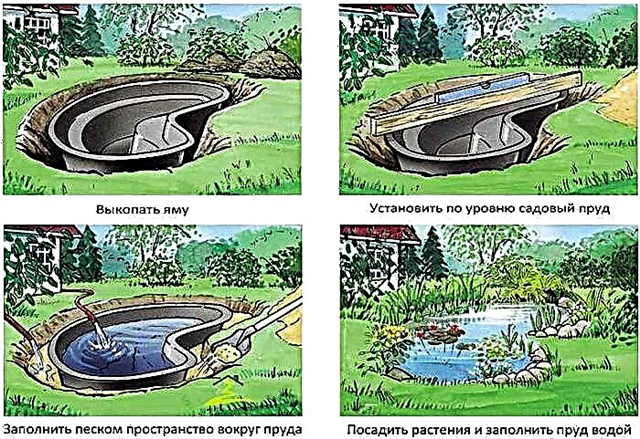
For the installation of such a reservoir, it is necessary to carry out the same preparatory work. The only difference is that the foundation pit will need to be cooked to the existing shape. This is sometimes quite difficult to do. It is necessary to accurately repeat the contours of the future capacity.

In black pond containers, UV protection is not included. Therefore, it is better to choose color options for the pond. All tanks for ponds are cascaded. You do not need to confuse them with pools whose walls are even, they will need to install additional reinforcement.
When installing large ponds, approximately 2 by 4 meters, supports must be installed under each bend of the form. This will save her from sagging and damage. It is better to fill the voids under the tank not with sand, but with earth with clay. So the form will hold better.

Film pond
The beginning of the creation of the pond is carried out from the same steps as in the previous options. It is necessary to make markings, dig a pit and in the process remove all large stones and roots.

Further actions are performed in the following sequence:
- Lay geotextiles in the pit of the pond. This is done in order to protect the film from the germination of weeds and roots and small stones that can damage it.
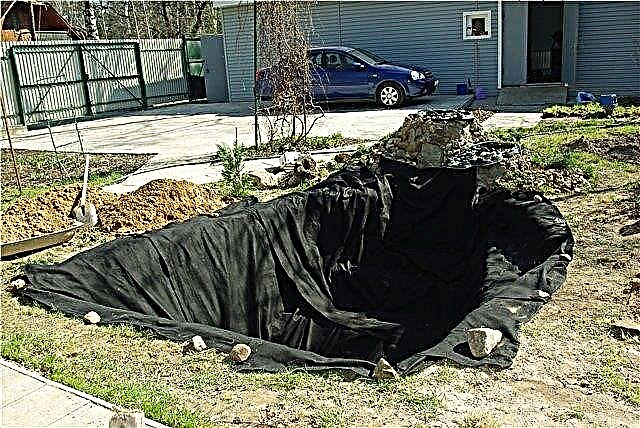
- The next step is to lay the EPDM film. It is distributed so that there is no strong tension. This condition must be observed in order to avoid a break due to water pressure. To distribute all the folds, you need to pour a little water into the pond. Under its influence, it will be seen where it is required to straighten the folds.
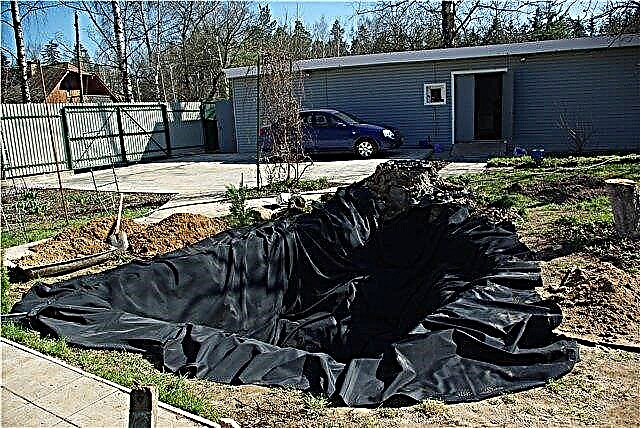
- Make the edge of the film. It must be wrapped and hidden under the ground. If during the filling of the pond it will be seen that there is a slope, then in these places you need to add land so that the water is at about the same level.
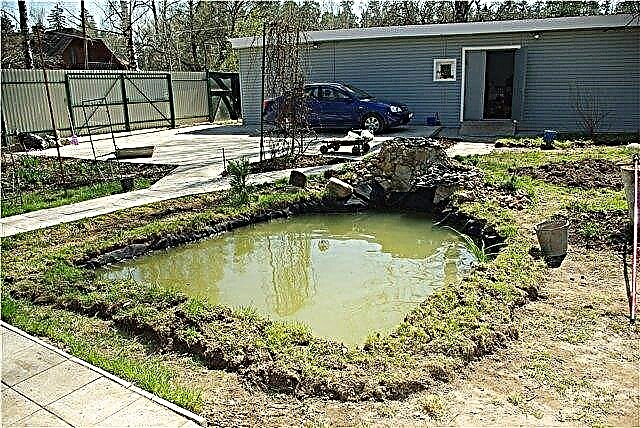
- The final stage of construction is the creative process of decorating the reservoir. There are many options for this, you can run into the pond the most suitable fish for such keeping: unpretentious carps and crucians, or you can decorate the coastal strip of the reservoir with plants and stones. For these purposes, you can purchase natural stone, which is sold retail and wholesale by construction stores.

Important! Before starting earthworks, in order to avoid an accident, it is necessary to make sure that in the place chosen for the location of the reservoir, the lines of power electric cables do not go underground! Information on this can be obtained from your local power grid company.
From the foregoing, it follows that organizing an artificial reservoir on your own personal plot of land is a feasible and feasible task. For its implementation, it is only necessary to set a specific goal, to have a certain amount of money and time to implement your idea.
Features
For some people, an artificial pond is not a decoration, but a necessity. If an annoying stream flows through your site or you have long been reconciled with swampy land, then the pond will thoroughly improve your situation. It is best to build a pond in the spring. For independent construction of the pond, there are many options that involve the use of special expensive materials or available (even improvised) tools. Such a construction does not require much time, effort and money. Only attention to detail and strict adherence to the recommendations will be required.

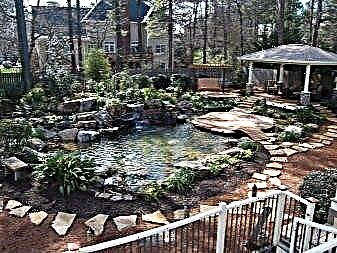
An artificial pond in the country is built for various purposes. It is by this criterion that one can distinguish the following types:
- Little. A small pond becomes part of landscape design. It is created to decorate a specific area in the garden. Near such a pond you can read a book in an armchair, but it does not imply an active rest.
- Decorative. Deeper than the previous version. Such a pond has a fountain inside, illumination along the perimeter, an openwork bridge and other decorative elements. The purpose of decorative ponds is to attract all the attention to themselves. Such ponds are located near the gazebo or outdoor terrace.
- For fish farming. Such a reservoir will please fishermen, children and cats. It’s nice to watch beautiful fish, and many species are great for dinner. It is important not only to start the fish, but also to create comfortable conditions for reproduction.
- For swimming. Own pond on the site - a good alternative to a simple pool. Such a pond is not limited only to aesthetic properties, but is also beneficial. A small pond will provide an opportunity to cool off in the heat, and a deep and large one will allow you to swim and play water games.
Key issues such as location, size, shape and styling are decided based on the type of reservoir. Therefore, first set a clear goal, only then proceed to the next steps.
Material
Modern manufacturers offer a large abundance of materials for the independent manufacture of the pond. It all depends on your goals and financial capabilities. For the right choice, you need to carefully study all possible options. For the construction of a swimming pond, the construction of a concrete bowl would be a good option.
Filling the pond allows you to use it for a long time. This option is quite expensive, but reliable. A more suitable and affordable option is polyvinyl chloride (PVC) or fiberglass. Reliability of materials allows the bowl to be used from 5 to 30 years, this directly depends on the work performed and the type of material. Both options for creating a pond create the desired depth and shape.


Purchased forms are a simplified option. It is enough to just dig a pit, mount the mold and reinforce the structure with sand. Plastic bowls are quite durable and easily tolerate winter frosts. Polypropylene bowls are afraid of ultraviolet rays and become unusable due to their prolonged exposure. The disadvantages of such structures are considered to be a rather high price and difficult transportation.
The bowl under the large pond will be difficult to bring to the destination without damage. Moreover, elementary installation skills of such structures will be needed, it is difficult for beginners to cope with such a task without damaging the bowl.
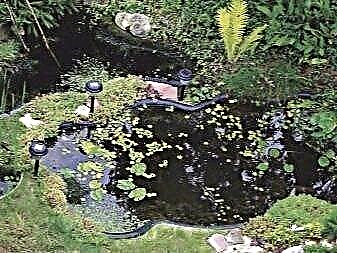

Of all the finished forms, the best option is considered to be a fiberglass design with a rubber base. This form is reliable and durable. If a problem occurs, it can be repaired, unlike simpler options. Such a bowl for a pond withstands a changeable climate. A rather interesting material for a pond in the country is a polymer film. With its help, you can create a pond of any desired shape.
Plastic film is the most affordable. Tempted by this option, be prepared that the pond will not please you for long. You can extend the pleasure with a PVC film. If you follow all the rules of installation and use, the film will last more than 10 years, as experts say. The material can be replaced with less costly, using old advertising banners. They are often sold at low prices.


Butyl rubber, made of rubber, is considered the most reliable film. Masters recommend the use of such material for those who have a pond of impressive depth, the bottom with many stones and roots.You can enjoy the pond with such waterproofing for 50 years. The great advantage of the material is its favorable reaction to repeated freezing and thawing. Specialized materials are the preferred option, but not the only one. Craftsmen offer such options:
- Old bath. Such an item can be painted and set on the surface, or can be lowered into the ground to an arbitrary depth. Together with a reservoir, you can easily install a small fountain.
- Tires. Variable use tires or wheels as the frame of a small pond.
- Basin. The installation method is similar to a bathtub. The item itself is so light that such ponds are often made by children and women, while they cannot handle the bath. It is important to pay special attention to the decor so as not to overload the space with details.
- Plastic bottles. Such material makes it possible to create small ponds with maximum speed. It is enough to cut the eggplant at the desired level and dig in the right place.
Keep in mind that it depends on the material how long the country pond will delight you. It is important to choose materials that do not harm the environment. Otherwise, toxins will penetrate the ground, and this will affect your harvest.
The size
It cannot be stated unequivocally that a large pond will cost more than a small one or will have better aesthetic properties. Optimal options need to be selected, starting from your goals. Key factors when choosing a size:
- Dimensions This parameter depends solely on the location of the reservoir. It is believed that a pond should cover no more than 3-10% of the total area of a summer cottage. There are no clear boundaries, it all depends on your preferences.
- Length and width. This criterion also largely depends on the size of the site, the purpose of the reservoir and on your capabilities. The latter concerns digging a pit - you can dig a small one yourself, for a large one you need special equipment.
- Depth. The larger the pond, the deeper it can be made. So, the mini-design can have a depth of several tens of centimeters, and a swimming pond for several meters.

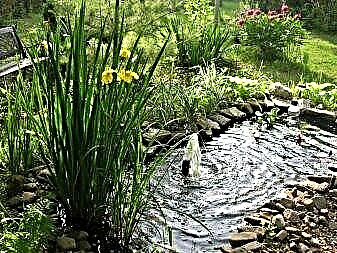
- Zoning is relevant for large bodies of water. Design experts recommend dividing the pond into 3 zones. The coastal zone is 10-40 cm deep for approaching the pond and planting ornamental plants. Shallow water zone - from 40 cm to 1 m, at this depth you can plant a winter-hardy water lily or nymphaeum. If this is a swimming pond, then just such a zone will make it possible to smoothly enter the water. Children can swim at shallow depths. The deep water zone is more than 1 meter deep, adults can swim here, and fish are also raised at this depth.
- Biodynamic equilibrium. This factor must be taken into account if various kinds of animals live in the pond. Ensure that the artificial pond can be cleaned on its own. Water purification in a pond with fish or plants using chlorine or ozone is not provided.
- Care. As a rule, the larger the pond, the easier it is to clean it. Be sure to think about ways to care for plants, fish and the pond itself.


Location
It is very important to properly position the pond. Especially when it comes to a large-scale structure that will serve you for more than one year. Important factors when choosing a place:
- Lot size. This factor is closely related to the size of the pond itself, and hence its location.
- Relief. It is important to consider the combination of land relief with the forms of the pond itself.
- Soil composition and groundwater. This factor is directly related to the maximum depth of the pond. In unfavorable circumstances, additional chores and material costs await you.
- Illumination. Choose a shaded place. It is impossible for the sun to fall on the water for more than 5-6 hours a day. Neglect of this factor leads to the active evaporation of water and to increased activity of bacteria. To select the desired location, monitor the solar regime for 2-3 days. It is especially important to correctly evaluate this criterion when breeding fish. In heated water, the amount of oxygen decreases, which can lead to the death of pets.
- Visibility. Choose a place so that the pond is visible from a window or gazebo. A decorative pond will become a visiting card of your site if it is noticeable at the entrance to the territory.


- Reflection. It is not strange, it is better to think in advance what will be reflected in your body of water. If the toilet in the courtyard or the barn is reflected, this can ruin the overall impression.
- The degree of landscaping. Make sure that the roots of the trees cannot damage the bowl of the pond. Also note that in autumn leaves and branches may fall into the pond, which will turn into silt at the bottom. Carelessness when choosing the right place can lead to difficulties in caring for the pond. If you really want to decorate the perimeter of the pond with bushes, then consider the option of plants in barrels (tubs).
- Power supply. Some decorative elements are powered by electricity. So, you can put an interesting fountain, make lights and much more. The main thing is to carefully consider the option of supplying electricity to water. It is better to think over this question at the design stage. It is safest to place wires underground in a reliable corrugation. For permanent access to them equip the hatch.
- Future extensions and improvements. Plan ahead. You might want to expand the pond or work out the recreation area near it in more detail. Provide free space on at least one side of the pond.


The tone of waterproofing is of great importance, affects the overall image. The bottom of the black color creates the illusion of a mirror. In such a reservoir, plants, the sky are perfectly reflected. The brown and black material allows you to create an imitation of natural soil, which is usually located at the bottom of the reservoir.
Blue and cream ponds are not very reminiscent of the creation of nature, but are an excellent option when breeding motley fish. Also, blue and gray tones are great for the pond in which you are going to swim. These colors mimic the bottom of the pool.
Thus, the color should be selected based on the purpose. The decorative pond will come closer to a natural look thanks to the dark bottom. For breeding fish and swimming, you should choose light colors, up to white.
Forms
It is almost impossible to describe all forms of ponds, because the fantasy of design masters knows no bounds. Conventionally, we can distinguish the correct geometric shapes and fantasy. Among the first, the most popular designs in the form of a circle, oval, rectangle. Fantasy forms are more bizarre, and this is their charm. Such ponds are most similar to the creation of nature, which does not tolerate rigor. Among the popular forms, it is precisely imitation of the natural form that can be distinguished.
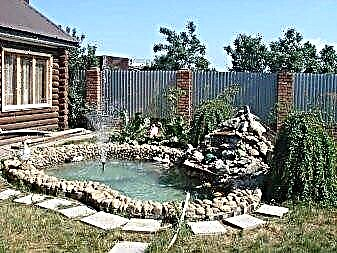
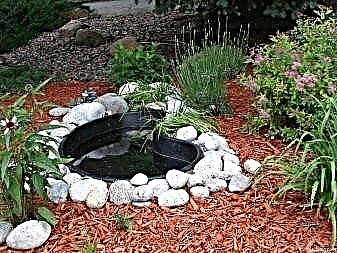
Style and Design
Design specialists responsibly declare that the country pond can be made in two versions, but they can have many modifications. Design Options:
- Formal. The name speaks for itself. Such a country pond has clear geometric shapes. This option is well suited for sites in the Art Nouveau, high-tech, minimalism, classic style. The formal include not only rectangular, square and round ponds. Broken figures also belong here, they can be both symmetric and asymmetric. The design of such ponds is strict. Classic neutral colors are used. A formal reservoir is characterized by a small number of additional decorative elements or their complete absence.
- Landscape. This option is more popular than the previous one. Such a pond has a fuzzy coastline, close to its natural appearance. It is the landscape style that makes it possible to create a harmonious balance between the artificial pond and nature itself. You can realize your wildest ideas. Before choosing a pond style, evaluate the topography of the site. Smooth soil guarantees the embodiment of any fantasy form.
Rises and depressions in the ground require careful study, but make it easy to build a cascade or waterfall. Bridges and slides look more natural on an intricate terrain.


You can create a suitable relief artificially. It will require the use of more complex technologies when working with the foundation. Carelessness will lead to distortion due to subsidence of the earth. A high pond (located above the ground) is also possible as part of the landscape design. There are many advantages of this design:
- Easy to care.
- The minimum amount of earthwork.
- Safety for children and pets.
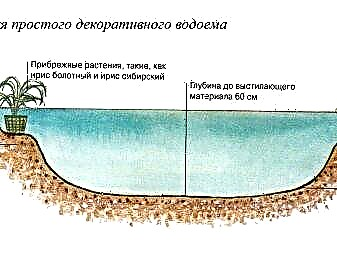
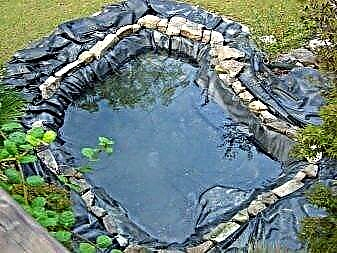
A pond from a bath is the most striking example of such a reservoir. The walls can be painted in Japanese style, which organically looks in the garden. Such an element will complement the overall landscape design of the site.
How to do it yourself?
Pond construction should be carried out according to clear instructions. So you can properly dig out the boiler and lay a waterproofing. The construction of the pond using film step by step:
- Pond making begins with a plan. Choose a convenient scale and draw absolutely everything, including the depth of each zone. It is recommended at the same stage to think over the decorative design. This is especially true if you plan to build a pond with a waterfall. A detailed plan will help you avoid mistakes.
- Now it is necessary to mark the future foundation pit. You can do this with a rope stretched over pegs, a rubber hose, or even sand (draw a contour with it). It is important that the shores are at the same height. Start digging a foundation pit based on a plan. Check their level from time to time.
- It's time for earthworks. Dig a hole the depth of which will correspond to the depth of the coastal zone. Make a marking, fix the line of deepening. Equip the second tier and make a line to dig out the deepest zone of the future pond. It is better to carry out excavation work together, and to hire an excavator for a large pond.
- After the hole is dug, you need to measure the dimensions and depth. Do this with a cord. To the resulting number add 50 cm on each side of the pit. Now you know how many PVC films you need to purchase.
- Cover the pit tightly with foil. Geotextiles can be laid under the bottom so that over time the roots of the trees do not damage the waterproofing. In addition, you can strengthen the structure using roofing felt or linoleum. Strengthening the shore and bottom can also be done with tightly compacted sand. It is recommended to perform this procedure on a sunny day, so the film will heat up and lie more densely on all the bends of the pit.
- The edges of the film must be tucked into a pre-prepared trench around the perimeter of the pond. Next, you need to fill the trench with rubble or other stone. This way you can securely fix the film.


- The shore should be strengthened, so that over time the earth does not crumble. Strengthen the edge of the pond with stone blocks or plastic pipes, they need to be nailed to the pegs. It is recommended to lay the edge with natural stone and complement the picture with large boulders.
- At this stage it is necessary put plantsthat will decorate the pond, in special baskets and install them in the right places in accordance with the plan. Lay out the bottom with a small stone or gravel.

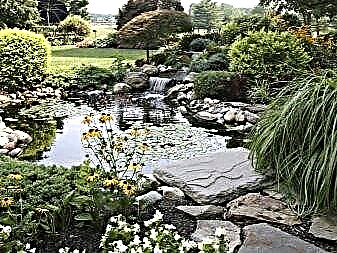
- It's time to pour water into the pond. The hose will be your best helper. It is not convenient to carry water in buckets, especially if the pond is large. Still water can bring a lot of problems, including an unpleasant odor. To eliminate this complexity, you can make a pond in a stream. To do this, simply raise the source slightly above the level of the pond, and feed water to it from the bowl itself using a pump. Such a device will save you from unnecessary trouble.
- Submersible Pump Installation, pipes to the stream source and filter connection are the last stage of technical work. It is recommended to use a pressure filter for water purification, it is more effective.
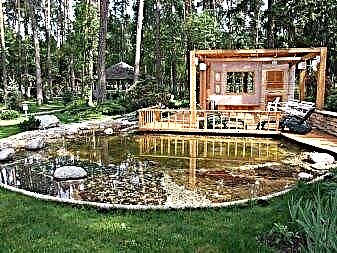

A more domestic version of the pond from the old bath can be done so that the old plumbing will be unrecognizable in its magical composition. The pond construction process can be performed according to the following instructions:
- Dig a hole under the bathroom so that the depth of the pit is 40 cm above the tank itself.
- Work the edges of the pit. On the perimeter, remove 35-45 cm of the earth.
- Deepen these strips so that the height is equal to the height of the bath.
Be sure to close the bathtub drain. You can use concrete or film for waterproofing. After that, lower the bathroom into the pit.


- Tape the inside of the bathtub with fine tiles or paint it with waterproof paint of the desired color. After that, cover the bathroom and let it dry completely.
- Cover the perimeter of the bath with a mesh netting. This material is considered to be the best for reinforcement.
- Coat the netting with a mixture of sand and cement.
- Spend decorative work. To do this, you can use stones, tiles, gravel and similar materials.

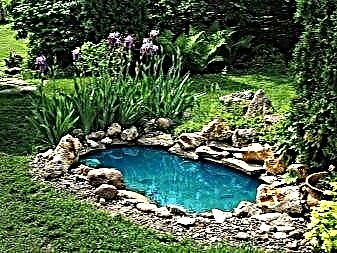
Necessary tools
The amount of inventory depends on how complex and diverse the pond you want to create. To build a simple pond, you will need:
- Shovel.
- Cart for the earth.
- Building level.
- Cord for marking.
- Pegs.
- Hose for water supply.
- Film for waterproofing a pond or any other base.

Such a minimum list is always needed. In addition to the above, you may need fences. So you protect animals and children. Decorative fences significantly affect the overall appearance of the artificial reservoir.
Equipment
To create a more complex composition, you need to acquire additional equipment:
- Water purification filter. This is especially important if you are creating a fish pond.
- Water pump. Such a device is used for pumping and pumping water, filters, fountains and waterfalls.
- Sterilizer. This fixture guarantees crystal clear water in the pond.
- Aerator (compressor). The device saturates water with oxygen. Actual in a pond with fish and plants. It is important to choose a model specifically for the pond, models for aquariums do not have the required power. You may have to use an excavator to dig a pit.
Plants and accessories
As a decoration, you can install a decorative fountain in the pond. The design can be bought ready-made or built independently. A decorative pond is often complemented by bridges. Garden figures near perfectly complement the composition. Flowers and plants in the pond require special attention. Plants are divided into deep and shallow.
The first land at the bottom in special baskets. They should occupy no more than 30% of the total area of the reservoir, otherwise it will turn into a swamp. Such busting can destroy other inhabitants of the reservoir, especially fish. Carefully plant flowers on the coast, keep in mind that they will grow over time.

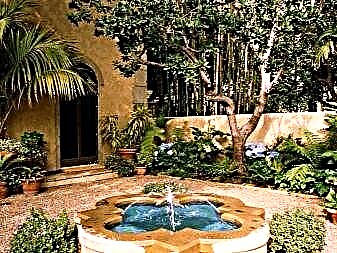
First of all, nymphs planted in the pond, and then they fill the bottom with decorative stone, starting from the deep zone. On the terrace you can plant a marsh calla, calamus, sedge, ditty, and gander. On the surface of the water, you can place a water hyacinth, a flyer, a gun or a swamp.
On the shore you can arrange a variety of types of iris, reeds, buzulnik, arunkus, miscanthus. The composition can be supplemented with perennials: hosts, buttercups, primroses, astilbe or swimsuits.
Peltiphyllum, loosestrife, Rogersia look great near an artificial pond.


Do you need fish?
The reservoir can be inhabited by different fauna. Ducks and even swans can live on the pond, it all depends on you. Most often, fish live in summer ponds. The choice of residents of the reservoir should be considered carefully. Most often, carp, goldfish, carps and tench become inhabitants of the ponds.Keep in mind that for one fish up to 15 cm in size, about 50 liters of water is needed. Suitable fish species:
- Koi carps. Fish are distinguished by intelligence and affection for the owners. Pets can even eat from your hands. The colors of the fish are quite interesting: yellow, blue, black, orange and white. In the conditions of an artificial pond they live for about 20-30 years and grow up to 90 cm.
- Gold fish. Such a fish will delight you up to 35 years and grow up to 45 cm. The weight of the fish does not exceed 1.5 kg. A daily portion of food is 3% of the weight of the fish. You can feed with dry mixes.


- Crucian colored. Goldfish is from 50 cm long and weighs from 3 kg, while silver crucian grows to 40 cm and weighs no more than 2 kg. For the winter period, you need to provide the fish with a simple condition - a depth of 1 m.
- Tench. On average, fish grow up to 20-40 cm. These fish are lazy in temperament and do not like to be active. Spend time at the bottom, near plants, do not like bright colors. The main advantage is unpretentiousness. Tench lives where many fish die.


Tips & Tricks
Specialists and experienced owners give such important recommendations:
- Position the bottom of the pond below the freezing point of the earth. It is especially important to follow this advice when building a fish pond. So you provide pets with the opportunity to survive the winter.
- Even the greenest pond should have 50% free space. It should be borne in mind that plants grow over time.
- Start building a summer cottage in the spring. So you will gain time for a complete arrangement of the composition and the pond will have time to take root.
- If you want a fountain - build a tall pond. So the composition will look more harmonious.

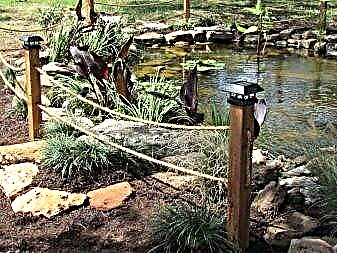
- Land from the boiler can be disposed of in several ways. You can distribute the soil throughout the garden and raise the ground level. You can also use this primer to create an artificial terrain.
- A high-quality water filter will help purify water even in the most difficult situations. The combination of mechanical and biological filters will completely deprive you of the hassle of water.
- Using stones, you can not only decorate a pond, but also fix flexible insulation. This option will add design durability and reliability.
- A special mesh construction helps protect your pond from falling leaves and branches.


- Pull the black thread over the shallow water to protect the fish from the hunting of birds and pets. For protection against cats, it is better to use a fence.
- The net will help clear water from fallen leaves and debris.
- Watch the growth of algae at the bottom of the pond. Get rid of surplus in time.
During the winter cold, pay more attention to the pond. Plants are better protected from frost. Ice from the surface can be removed manually.


Beautiful examples and options
Decoration of a homemade pond can be not only aesthetic, but also functional. The construction of streams and fountains creates the effect of a natural flow of water. Such a pond can stretch across the entire garden. The creek should be made of the same materials as the pond itself. So all the components will merge into a harmonious ensemble. Decorating the space around the reservoir can dramatically change the overall impression of the site.
Lay out the path to work with a decorative stone. An interesting result is the use of fragments of different sizes.
So you can arrange all the trails on the cottage. In this case, your pond will fit more harmoniously into the overall design.
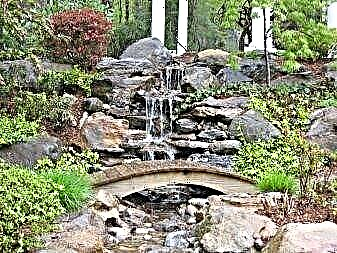

An excellent option for a country house will be a fabulous garden. Lay out the tracks with colored plates. Decorate the pond like a magical place. Plant plants with leaves of irregular shapes. Launch colorful fish in a pond. The boulders around the pond can be painted with bright colors. With the help of decorative lights or lights, you can achieve an extremely interesting result.
A pleasant light on a summer evening will create a special cosiness and emphasize the unusual nature of a home-made pond. Flashlights of different colors will help create a real fairy tale and the effect of magic. Illumination inside the pond looks especially impressive if interesting representatives of flora and fauna live in it. Such a pond will not leave you and your guests indifferent.
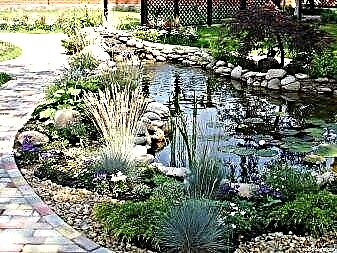

If your pond is designed for swimming, then it’s important to design a perimeter zone in the form of a sunny beach. Protect some space from the rest of the plot with a fence. From the pond to the fence, sprinkle sand and put sun loungers, a table, an umbrella. Such a pleasant atmosphere is conducive to relaxation. A great composition of a bridge, lanterns and a waterfall will never get bored.
Such a magical place in the middle of your garden will radically change the overall atmosphere. Near such a construction, place a gazebo with soft rocking chairs. Near the pond it will be nice to be in any weather. Colorful fish or colorful pebbles at the bottom of the pond will make it more fun and attractive. This design is especially advantageous for families with children. Little inhabitants of the house will definitely appreciate this design.

See how to make a pond with your own hands in the next video.
Types of reservoirs in landscape design
The main types of reservoirs that landscape designers embody:
Each of these varieties has its own characteristics and design requirements.
The species in question is a reservoir created as a result of the closure of a natural watercourse. Ponds usually arise due to the construction of a dam in the path of some small river. Today, this species is understood as a body of water with standing water. The choice of shape and size depends on the preferences of the owner. Depth varies from a few centimeters to two meters or more.
If you want to breed fish in a pond or plant plants that will survive the winter, then certain rules must be taken into account:
- crops require a depth of 0.5–1 m,
- water inhabitants - 1.8–2 m.
The fountain
This species is considered not only a beautiful decorative element of the site, but also a good way to constantly humidify the air. Fountains are divided into submersible and stationary. The first type is usually installed directly in the pond, which allows oxygen to circulate well in water. The system works like this: a pump pumps liquid out of a reservoir, passing it to a fountain. This circular circulation of water allows the water to not stagnate.
A stationary fountain is considered an integral part of the landscape. There are many models in the form of statues, water mills, etc. To create fountains, you should have a pump (the pressure of the water depends on its power), a container with liquid, and a specialized nozzle. The last element can be selected for every taste: bell-shaped, tulip, inkjet or turntable. When placing the fountain, you need to understand the larger its dimensions, the farther it should be from the building.
Often you can find a non-jet type. This fountain looks like this: water flows from the walls, sculpture-mask (mascaron) or bowl. Evening lighting adds a special charm and a sense of magic.
Waterfall
This type of reservoir is an excellent pacifying element in a noisy area. Many homeowners prefer to create artificial waterfalls on their sites to drown out the hum of cars.
The noise of falling water depends on the height of the device itself and on the flow. It is best to purchase a pump that will allow you to adjust the pressure of the liquid. It is recommended that you select a terrain under a slope near undersized or artisan plants.
Spring
The type in question is a body of water that does not have a mirrored water surface. To build a spring, it is necessary to install a pump and a tank of water underground, and the fountain nozzle (the best option is a geyser) should be brought to the surface. This type is a fairly compact structure and can be installed both in the shady area of the garden, and in the patio or on the lawn.
Creek
It is a narrow watercourse, which is characterized by a winding channel. It is recommended to design a stream in such a way that there are more bends and various obstacles. This is necessary to create a natural movement of water. Equip streams near the reservoir in such a way that the pump pumps the liquid. The pressure of the flow depends on the girth of the channel and the angle of its inclination. On flat sections the stream will be wide enough, but slowly flowing, and under a large slope the stream will become much more powerful.
Decorative swamp
The considered type of reservoir is increasingly being established to decorate the territory. The best option is when a decorative swamp is combined with a pond or stream. This water form is usually shallow due to the surface roots of plants that are intended for planting in the water area. It is very important to monitor the waterproofing in the decorative swamp so that the flora does not die as a result of water leakage.
Pool
Unlike other reservoirs, the pool carries a different functional load - swimming. The decoration of the pools depends on the preferences of the owner. The bottom and walls are laid out with tiles, both plain and patterned in various colors. The recreation area around the pool is decorated with sun loungers, awnings or small umbrellas. For families with children, a miniature water slide or springboard is recommended.
What materials can be built pond
Decorative reservoirs can be constructed using ready-made foundations, improvised tools and various devices. The choice depends on the preferences and capabilities of the owner of the site in the country.
The following materials are considered the most used materials for creating ponds:
- ready-made plastic containers
- synthetic film
- concrete,
- tires
- bath,
- the pelvis.
Plastic
For the construction of tanks for ponds, either compressed polyethylene or polyvinyl chloride is usually used. The appearance of these finished forms can be varied in style, size and depth. The volume can be from 150 to 2500 liters.
- The main advantages can be considered:
- light weight and durability
- simple installation
- service time - up to 15 years,
- minimum care requirements.
- You should also outline some of the disadvantages of these reservoirs:
- when choosing cheap options there is a high probability of their destruction from frost and the sun,
- there is no way to expand the volume, complete dismantling is required,
- high price of a quality product,
- unnaturalness.
Synthetic film
- Home-made decorative ponds on a film basis are considered the most popular. The main advantages of such reservoirs are:
- the creation of various forms and the desired depth,
- possible further correction of the outlines,
- admissibility of restoration of various damages,
- high frost resistance.
- Despite the advantages of such material, experts identify a number of disadvantages of ponds on a film basis:
- insufficient strength of the material,
- possible damage to the edges of the film base under the influence of sunlight
- application of additional disguise,
- gluing the ends of the film in different places during the construction of overall options.
Concrete
The construction of decorative ponds using the specified raw materials is necessary when installing bridges or statues, but the material is not very popular.
- The main advantages of using concrete for water bodies are:
- durability and reliability
- resistance to damage, both mechanical and climatic,
- durability,
- lack of need for leaving.
- In addition, there are a number of shortcomings in the creation of such ponds:
- construction complexity
- high price,
- purchase of additional materials,
- impossibility of reconstruction.
From the tire
- The considered option is especially convenient if unnecessary car tires have accumulated on the site. The main advantages of such reservoirs can be considered:
- strength and durability (over 10 years),
- size selection
- high frost resistance and resistance to ultraviolet rays,
- there is no need to further strengthen the walls,
- admissibility of coloring and decoration,
- ease of installation
- cheapness.
- The disadvantages include:
- size and shape restrictions,
- the impossibility of building overall options,
- You cannot expand the originally mounted pond.
Using bath
This "base" is often used in summer cottages. Cast iron bathtubs are a particularly good option, as they are highly resistant to temperature extremes.
- The main advantages of such a reservoir are:
- strength and durability
- noiseless water intake in a cast-iron tank,
- ease of installation.
- The negative points include:
- the difficulty of moving (a large mass of the product is 50-150 kg),
- insufficient enamel resistance to various kinds of influences,
- unnaturalness of the pond due to the uniform form.
Mini basin from the basin
This option is a real find for owners of small summer cottages, where it is problematic to place a more dimensional basis for the pond.
- The main advantages of such a reservoir can be considered:
- low cost
- compactness
- transportability
- minimum care
- Simple and quick installation.
- Despite the many positive features, this option has some disadvantages:
- quick freezing of water in winter and overheating of liquid in summer,
- restriction in shape (round) and size,
- the impossibility of further increasing the reservoir.
To create a mini-pond, it is recommended to use enameled, cast-iron and metal basins. They should first be coated with a solution of cement and sand (1: 3). Water should be added in such an amount that it is convenient to sculpt. The future reservoir will dry for about a day.
Do-it-yourself pond technology
Features of the creation of the pond imply following certain rules.
To get a beautiful reservoir, you must:
- choose the installation location
- prepare the necessary materials,
- perform step-by-step installation
- to decorate.
Necessary materials
For the construction of a reservoir, special tools, supplies and other goods should be purchased. The fixtures needed to create this element of landscape decoration will depend on the underlying material. As previously indicated, for the construction of a reservoir, you can buy synthetic film, ready-made plastic tanks, as well as it is permissible to use existing products (basins, tires, bathtubs).
The list of necessary materials include:
- reinforcing wire
- primer,
- cement,
- sand,
- roofing material
- reinforced mesh.
Also in stores you can buy film, EPDM membranes, pebbles and rubble, a coconut mat, lights and various decorative elements.
The list of necessary tools includes:
- scoop, shovel,
- welding machine,
- concrete mixer,
- brushes and brushes
- buckets and more.
Shopping list may increase and decrease depending on:
- places
- bumps
- service life
- construction time
- prices.
Step by step instructions for creating
To get a beautiful body of water, it is recommended to follow certain rules.
Do-it-yourself water element creation of landscape design is carried out, adhering to such stages:
- Blueprints. It is recommended to recreate the plan of the territory on graph paper with notes: “north”, “house”, “large trees” and other objects. It is also necessary to highlight sunny and dark places with notes. In the right place, draw the outline of the reservoir, highlighting the tiers (for coastal crops - depth 0.3 m, for shallow water lilies - 0.6 m, for recesses - 1 m, for wintering fish - 1.5–2 m).
- Digging a pit. For this it is necessary to use small construction equipment. The place is marked with stakes and twine, you can also use the garden hose.In the absence of equipment, you can dig a foundation pit with a shovel, checking the level of different heights of the shores. Next, manual adjustment work is carried out to form the bottom, walls and various protrusions. Tiers can be formed with a shovel. Do not make vertical walls of the recesses and the reservoir as a whole, but tilt 30–45 °. After - it is necessary to measure the parameters of the pond bowl to acquire synthetic film and geotextiles. Material allowance - 0.5 m.
- Sealing. The bottom must be cleaned and strewn with sand, which must be well compacted. Sealing is carried out using geotextiles, on top of which the film is laid out. A trench is dug around the pond, into which gravel is poured, holding and fixing the film material. Next, the future body of water must be left for a day, after which it is necessary to smooth out all the folds and smooth out the errors and trim the excess pieces. The next layer is the blind area (0.25 m). It can be large decorative stones or flat pebbles. The coastline is fixed with concrete.
- Final stage. The finished tank is filled with plants, water, and also decorated.
To create a reservoir on a concrete basis, you must follow these steps:
- Registration of the pit. The walls form at an inclination of 30–45 °. The soil on the lateral surfaces and at the bottom of the pit must be tamped.
- Waterproofing. Cover the inside of the future pond with a thick layer of synthetic film.
- Concreting. The walls and bottom of the recess are poured with a ten-centimeter layer of concrete.
- Fittings. The surface of the bowl must be strengthened with a metal mesh, pressing it into still soft concrete.
- The final coating. The reinforcement is poured with a five-centimeter layer of concrete, which must be compacted and well leveled.
Decorative elements and site decoration
From the moment the blind area froze, you can begin to equip the pond with various decorative elements and plant coastal crops. The best option is to immerse them in a pond in containers. It is best to first plant several varieties of perennials that do not require special care. For a terrace with a depth of 0.3 m, sedge or calamus can be used.
It is recommended to place plants in black pots. This color provides invisibility to the landing packaging. And during wintering, plants can be easily removed from a reservoir with containers. Next, you need to fill the pond with water. Experts say that at first the pond will become cloudy due to blue-green algae. This should not be feared, as they will soon perish, and the water will be purified again.
Water lilies are planted initially in pots in shallow water (0.3 m), and after the growth is activated, they are moved to a terrace with a depth of 0.6 m or more. The coastal area is decorated with fern, hosta and other hygrophilous plants. For better water circulation, it is recommended to place a stream and a waterfall in the pond. For the construction of the structure it is necessary to use a submersible pump. Water will flow through the feed hose, which is mounted on a raised platform. All technical elements are masked by pebbles and decorative stones. Further, the structure is reinforced with concrete.
In such a reservoir, you can run fish and toads. But for water residents, the permissible level of acidity of the water should be 7-8 pH. To adjust the performance in specialized stores, you can purchase various drugs for this purpose. Recommended temperature regime is about + 15 ° С. The classic version of decoration in the ancient Greek style is the use of figurines, amphora, various symbols of antiquity. The Japanese style implies decoration with figures of toads, coins and decorative lanterns.
Further care of the pond
A necessary condition for maintaining the engineering element of landscape design in a beautiful form is regular care. With the right choice of place and the right technology of construction, you will not have to devote much time to the reservoir.
Despite this, no one is safe from such situations:
- flowering
- pollution
- lack of oxygen in the water.
The first problem can be solved by harvesting algae with a rake and a pitchfork. A filter in the pond can also be a good helper. The use of chemicals should only be in extreme cases, since such drugs can harm the flora and fauna of the reservoir. Darkening of water or the presence of sludge on the surface indicates the need to replace the liquid.
This procedure is performed as follows:
- Extract plants using a net or manually.
- Partially drain the water and catch the fish by moving them to the prepared tanks.
- Empty the thicket from debris and dirt.
- Fill the pond with water, and reinstall the plants and place the fish.
The problem of aeration is especially important for the reservoirs in which fish live.
To saturate water with oxygen, the pond must be equipped with one of these devices:
- mini air compressor
- bottom aeration system
- floating or fountain aerator.
Ponds also require seasonal care. In the spring you need:
- clean the bottom of contaminants,
- check for damage,
- pruning bushes (to a height of 0.2 m),
- cutting plants in the coastal zone,
- transplantation of annual crops (after frost, if necessary),
- inclusion of filters and fountains,
- checking the acidity of water.
Summer care includes:
- cleaning the reservoir of debris,
- planting tropical plants,
- fertilizer,
- thinning algae,
- weeding from weeds and overgrown trees,
- checking the pH level.
Autumn procedures cover:
- tank cleaning
- sanitary crop pruning in coastal and shallow areas,
- the movement of thermophilic plants into the room (from the moment of frost),
- at a temperature of + 9 ... + 10 ° С the termination of top dressing of fish,
- in reservoirs with a depth of less than 2 m, catch aquatic inhabitants for wintering in tanks,
- installation of expansion joints for ice expansion.
- drainage of small ponds.
Winter care is also necessary for the landscape design component. The procedure involves the following actions:
- drain water from a concrete bowl,
- drain fluid from hoses and pipes,
- dismantle pumps and filters,
- turn on the defroster,
- to cover the pond with a net,
- provide fish with oxygen (wormwood).
The creation and maintenance of a pond must be approached with particular responsibility. In order for the considered landscape design element to always be pleasing to the eye, it is necessary to initially select the right place, type of water body, determine its shape and size, design it correctly by following step-by-step instructions, and also monitor its condition by conducting seasonal planned procedures.
Where to start the construction of a pond on the site
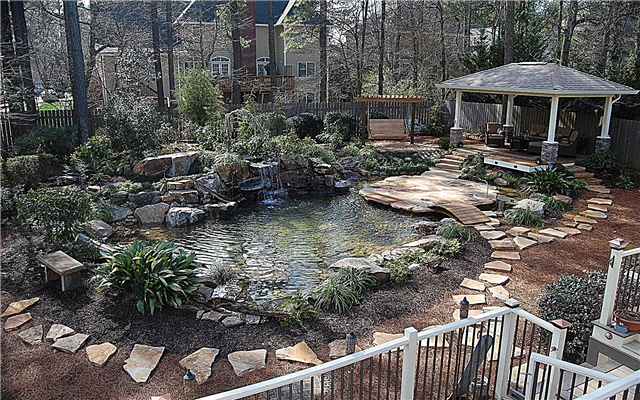
Preparation of materials and tools
First of all, you need to understand that the volume of the pond is impressive, large, even if you are going to make it small. Therefore, it is necessary to prepare special earthmoving equipment.
- You will need an excavator or any other equipment that can dig a deep hole.
- Also, in addition to machinery digging the ground, freight transport is necessary for the removal of excavated soil. If you are not going to transport soil, but just want to use it as a filler for pits and irregularities in your area, then the truck will most likely not be useful to you.
- From hand tools, you need a shovel to eliminate all the bumps and give the future pond the correct and desired shape.
In addition to tools, you need to stock up with finishing materials, but we will talk about them a little later.

Step-by-step instructions for building a pond on a site
First you need to determine the type of pond that you are going to build. Basically, there are at least four types of ponds:
- Mini pond on the plot. In size, it is much smaller than usual. It looks good in small areas that literally do not allow you to install a large pond. Its creation does not require a large number of materials, and the price is not very high.
- Pond on the site. It is great not only as a decorative decoration, but also as a way of breeding fish. Moreover, the cultivation of fish is understood not simply as keeping it in a pond, but specifically increasing its number in a natural way.
- Pond with decorative elements.. Unlike the previous ones, this pond is filled with various decorative elements that stand out from the water. Ideal for decorating the territory of your site.
- Pool on the site. Allows people not only to admire their beauty, but also to swim in it in hot weather. You can invite guests and enjoy warm water in the heat together.

Basically, any kind of pond is built in the same way, only its size is a characteristic difference. Therefore, this step-by-step instruction is suitable for almost everyone.
- First of all, you need to determine the presence of groundwater and find out the depth to them. Then determine the location of the pond on the territory. The following factors must be taken into account: the presence of light to maintain the desired water temperature and a favorable environment for plants planted near it. Also make sure that the soil is dense and during construction will not begin to crumble. Make sure that in this place there are no underground communication lines.
- After preparatory work in the field of theoretical location, we proceed directly to the dimensions of the pond itself. For plants, a depth of about 30 centimeters for short and 40-90 centimeters for tall is needed. If your task is to breed or keep fish, then in this case the depth should be from 1 meter.

- Next, the work of an excavator is required. Keep in mind the fact that the equipment will spoil your site. A huge mass of dug soil is also formed. We give the future pond the shape you need. After this, you need to make sure that there are no sharp objects and stones at the bottom of the pit and on the sides, if necessary, remove them.
- In order to prevent the water from leaking, it is important to cover the bottom with a sealed base, but only if there is no groundwater, and water from the pond will leak through the rock over time. You can cover the bottom of the PVC film and make sure there are no gaps. Fix the material, and fill the pit with water. Only a day later, when the soil under the mass of water completely settles and the film takes on its final shape, it is possible to remove the excess remaining parts of the coating and proceed to decorate the pond.
Pond equipment on site
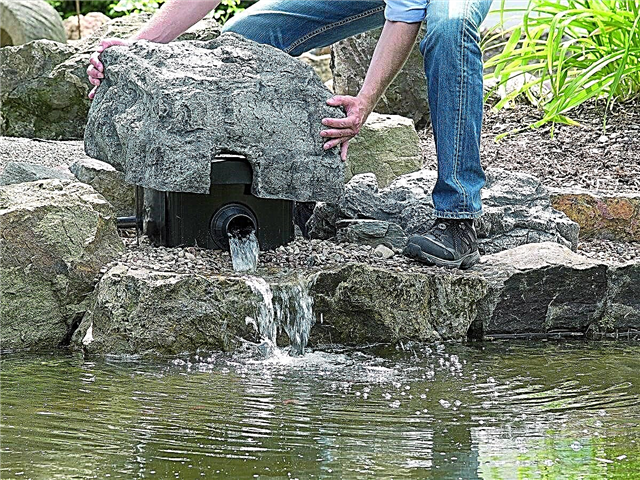
After some time, various debris will appear on the surface of the water. These are tree branches, dry grass, foliage or needles, depending on the type of plants nearby. In addition to all this, the water itself will take on a muddy, contaminated appearance. To avoid these troubles, it is necessary to pass water through a special filter. The filter for the pond is designed to destroy microorganisms, through whose fault a phenomenon such as blooming water occurs. In addition, the filter is the tool through which the small debris and dirt trapped in the pond is delayed and eliminated. There are several ways to filter a pond:
- Pressure filtration of the pond. Cheap and practical system. It is used in the presence of a fountain. Through it, under pressure, water passes and returns to the body of water already purified.
- Pressureless pond filtration. Consists of tanks filled with special material. Water is purified after passing through them.
- Sand filtration of the pond. Consists of sifted quartz sand and gravel; cleaning takes place by backwashing.
Final work in the construction of the pond

Planting plants in a pond
One of the decorative ornaments of the pond is the saturation of its vegetation. Plants can be planted not only near the pond, but also in the water itself. It should be noted that plants must be adapted to this, otherwise they can easily die. Flora can be either submerged in water or floating on the surface of the water. Freely floating, as a rule, are immersed in water and are not tied by the root system to the bottom of the tank. Others, on the contrary, have a root system and are tied to a specific place. When planting plants in water, you need to make sure of the climate under which they can fully grow and delight our eyes. For coastal plants, everything is much simpler. For the most part, they do not need constant care. With the necessary enrichment with water, plants will be able to grow independently.

Running fish in a pond
You can launch fish into the pond only when all the favorable conditions for its life are met. I.e:
- water is saturated with oxygen,
- timely cleaning of the pond from pollution,
- It is also important to remember a factor such as feeding the fish. To do this, you need to buy food in specialized stores and make sure that it is enough for everyone,
- observe the number of fish, as they are characterized by frequent reproduction,
- not to run into the pond predatory fish species, it can lead to the extinction of other species,
- To start the fish in the pond, you need to put the fish in a solution of salt and water from a reservoir. After 3 minutes, you can safely release it into the pond.

Pond and equipment care
When cleaning a reservoir with various filters, do not forget that the filters themselves are clogged and should also be cleaned. This also applies to pumps. Timely cleaning will help keep the pond clean. In addition, you will need a landing net (a large landing net on a long handle), with which you can manually catch garbage from the surface of the water. If your pond is large, then you can not change the water for years, thanks to the biocenosis. But if it is isolated from the ground with a PVC film, then the water in the pond should be changed at least 2-3 times a year.
The pond is one of the luxurious decorative structures in the summer cottage. Even with a minimal budget, you can make your dream come true. Financial costs are necessary only when hiring special equipment and further decorating the pond. Further exploitation will not require large financial investments and efforts from you, you just have to enjoy the result of the work done.







 It fits along the entire perimeter. At this stage, even before pouring concrete, a drain pipe should be installed. It is also necessary to consider the location of the power cable if a filter pump is installed.
It fits along the entire perimeter. At this stage, even before pouring concrete, a drain pipe should be installed. It is also necessary to consider the location of the power cable if a filter pump is installed. 
 They can be gentle or have a certain shape. At this stage, it is necessary to use concrete solutions of the highest grades suitable for the construction of reliable monolithic structures.
They can be gentle or have a certain shape. At this stage, it is necessary to use concrete solutions of the highest grades suitable for the construction of reliable monolithic structures. 







